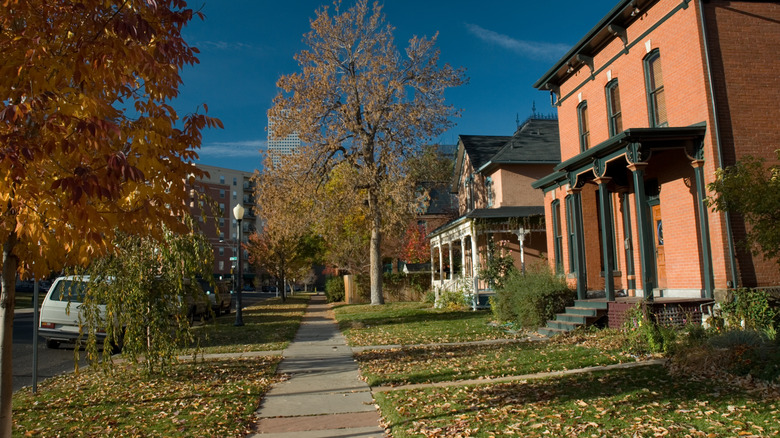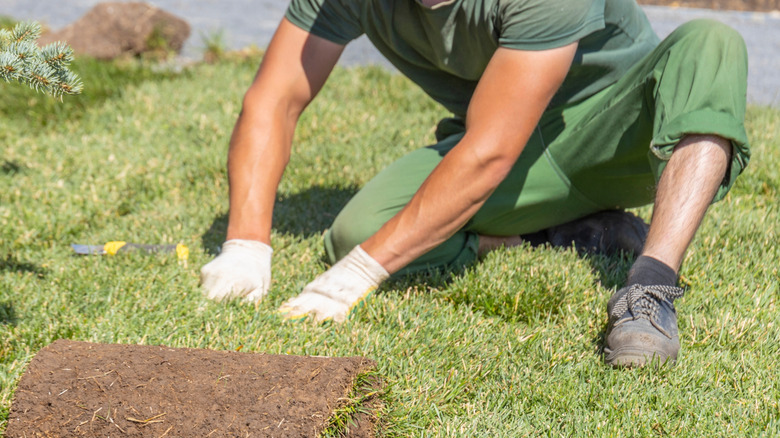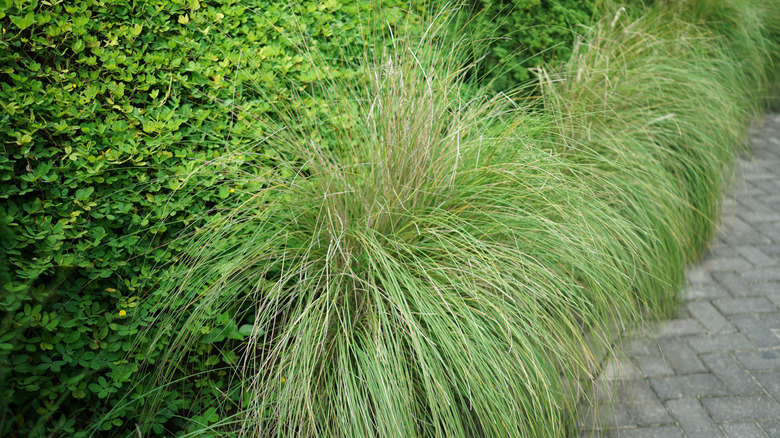What To Consider When Landscaping Your Front Yard's Park Strip
We may receive a commission on purchases made from links.
The narrow patch of land separating your front yard from the street, also known as a park or hell strip, can be challenging to landscape. This area is unusually skinny, offering limited space for plants to spread their roots. It's difficult to water, endures high heat, and is frequently stepped on, parked over, or subjected to pet excrement. It may even have compacted or poor soil, particularly in snowy regions where sprinkling road salts is the norm. However, such difficulties aren't a reason enough to leave your park strip in poor shape. After all, this part of the landscape helps boost your home's curb appeal when maintained well.
Bryan Clayton, CEO of GreenPal, shared similar sentiments in an exclusive House Digest interview. "I've landscaped thousands of yards over the past 22 years, and I can tell you — that little strip of grass out front might not seem like a big deal, but it really says a lot about how you take care of your property," he said. While he acknowledged that keeping this land parcel in tip-top shape isn't easy, he still made the case for covering it with turfgrass. "That park strip is tough because it's hard to keep looking nice, but trust me, a thick, well-maintained row of grass there makes a huge difference. It gives your place that subtle feeling of luxury — like you actually put thought and care into the details." So, how can you landscape your front yard's park strip with grass? Here are the deets.
Sodding your front yard's parking strip with grass
Justifying his choice to lay grass on the meridian, Clayton said in his exclusive interview with House Digest, "... nothing beats a sharp-looking, lush patch of turf grass with clean edges. It sounds simple, but honestly, it takes some investment. That's the funny thing about 'quiet luxury' — it looks effortless, but it requires real work and resources to pull off."
Clayton mapped out the process as follows: "Dig that area out and replace it with good, nutrient-rich soil first." You may use a digging fork, such as GSBLUNIE's 5-Tine Heavy Duty Pitchfork, to loosen the soil. But if you haven't cultivated your park strip before, spading the area to break the compaction may become necessary. Kemaier's Long Handle Garden Trowel is one option. After you put in the new soil, "... lay down some high-quality sod — don't skimp on this part," Clayton added. Look for sods best adapted to your area, although popular offerings are typically a blend of tall fescue and Kentucky bluegrass. Ensure the sod is certified, so you can rest assured it isn't harboring weeds or invasive species. For maintenance, Clayton recommended adding a drip irrigation system. "Watering this little strip can be tricky, so drip irrigation is a lifesaver. It keeps the grass lush without a ton of hassle." Alternatively, you may use this clever hose hack to easily water the ribbons of turf.
Invest in ornamentals or groundcovers if municipal laws allow
Admittedly, with homeowners gravitating towards implementing low-maintenance ways to create eye-catching front yards and park strips, not all might be keen on investing in sod. However, as hell strips are usually classified as a public right-of-way, your planting choices may be limited by city guidelines despite being your responsibility.
Commenting on this during his exclusive chat with House Digest, Clayton said, "Now, most cities won't let you get too creative with plants or rocks there, so you're likely stuck with turf. But check your local regulations anyway — you might get lucky and be able to use monkey grass or even a durable ground cover like wintercreeper, which you can edge nicely with a weed eater." For instance, Lincoln, Nebraska allows the use of ground covers, ornamental grasses, perennials, and even vegetables so long the final growth doesn't breach 30 inches, keeping the sight lines open for motorists.
If you choose to go this route, prioritize plants that have minimal watering needs, especially in arid, drought-stressed environments. Ensure they have neat habits, so they don't sprawl on the road, interfere with foot traffic, or impede access to utilities. Also, be mindful of pedestrians and pets and avoid any prickly, thorny, or bee-attracting plants.


